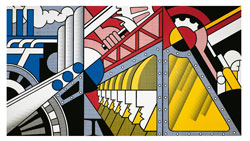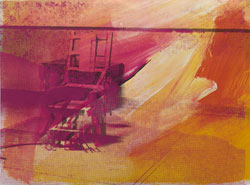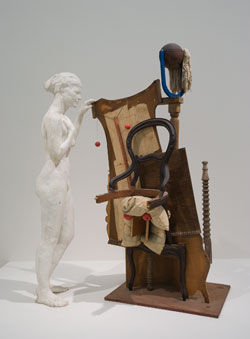Artist
Roy Lichtenstein Preparedness 1968

Roy LICHTENSTEIN
American 1923–97
Preparedness 1968
oil and Magna on canvas, 3 panels
304.8 x 548.7 cm
Solomon R. Guggenheim Museum, New York
© Roy Lichtenstein/LICHTENSTEIN, New York. Licensed by VISCOPY Australia
69.1885
"From the beginning, I felt that comic-strip painting had to be de-personalised. It had to express great emotions – passion, fear, violence – in an impersonal, removed and mechanical manner"
Roy Lichtenstein, born America 1923
Sources of Inspiration
Around the end of 1961 Roy Lichtenstein broke from his abstract methods and discovered cartoons as both inspiration and source-material for his art. His preferred material was romance or war-inspired, but when reinterpreted by Lichtenstein the comics are always laced with irony.
Central to Lichtenstein’s identification as a Pop artist is his use of the Benday dot, the standardized tool of poor quality printing of junk mail pamphlets, newspaper imagery and comic strips, and the 1960s equivalent of the pixel.
In an interview, Lichtenstein explained his choice of comic frames for his works:
"I try to look for something that says something mysterious, or absurd, or obvious or extremely simple or extremely complicated. Something visually or if there are words to it – something that when it’s a painting and not a part of a comic strip that it will strike you as funny…or…usually funny. ……….. It’s the drama and heroics and of course, none of the consequences – we still think of war that way."
Roy Lichtenstein
Lichtenstein developed an avant-garde style that was intellectually challenging and culturally disruptive, yet his works and their terms of reference were also accessible to the general public.
Lichtenstein described Preparedness, which is seen here, as
"a mural-esque painting about our military-industrial complex."
It was painted in 1968, a year in which public opinion on American involvement in the Vietnam War shifted dramatically. Back in 1943, Lichtenstein had been drafted into the US army, serving in Europe in World War II for three years. Perhaps informed by his personal experience of war, Preparedness was intended as a direct social comment; a questioning of nationalistic optimism that comes with a call-to-arms. He said:
"You realise that I’m not serious about the glory of defending our shores against foreign devils, as these works would imply. But the purpose isn’t only the reverse. It is also a statement about ‘heroic’ composition."
Part of the dynamism of this work lies in the strengths of the altar-like triptych. Its size recalls a billboard promotion, where advertising – even of the most unnecessary or unsavoury products or ideas – enters the public sphere as a form of unchecked social preaching.

